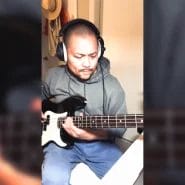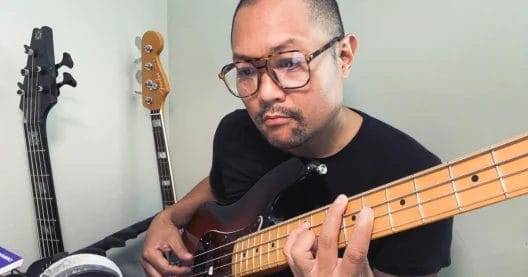Learning the bass guitar is both challenging and rewarding. And, whether you’re aspiring to become a session bass player, join a band, or simply just want to play music, developing an effective daily practice routine based on your current level and goals is a must. In this guide, I’ll share my personal take for developing a bass practice routine, that way you can make consistent progress and find joy in every note you play.
Let’s dive in.
Scrap The S.M.A.R.T. Goals. Instead, Focus on Joy, Journey, and Jam!
There’s no universal one-size-fits all “best practice routine.” Every person’s path will be unique, and will (and should) change as you progress in your learning. It’s okay to change up your routine, even on a weekly basis, especially if you’re not enjoying what you’re doing.
You’ve probably heard of S.M.A.R.T. goals (specific, measurable, actionable, relevant, and time-bound). I know this isn’t a popular opinion, but personally, I find the S.M.A.R.T. approach to be dry, uninspiring, and corporate — especially the time-bound part. I don’t know any kid that likes to hear they have 5 minutes left in the playground!
Instead, I like to think about the 3 J’s when it comes to developing a practice routine:
- Joy: What brings you joy right now? What inspires you right now? Your excitement determines your path.
- Journey: Where are you in your journey? Are you just beginning or somewhere further along?
- Jam: Play, play, play! Fun keeps you curious and is the secret to make you a better bass player faster.
I’ve been playing the bass guitar for more than two decades and my greatest growth occurred whenever I was simply enjoying the process and having fun.

Having that said, let’s get some clarity with the first two J’s: Joy and Journey. Those two things will determine your approach in the practice room and your exact strategy for making progress on a daily basis.
Develop An Inspiring Foundation For Your Practice Routine (What’s Your Joy?)
Focus on what brings you the most excitement, not what someone else says you “must” practice learning. You can still learn if you’re not excited or inspired about something, but you’ll absorb material more quickly if you are.
So, take a look at the music you’re playing on repeat. Who are you listening to on Spotify? Whose videos do you keep watching and listening to over and over? Or, is there a band that you often see live? This is your entry-point!
Trying to learn what you’re already absorbing on a daily basis will make the process so much more fun and easy! And you won’t be trying to memorize anything, because you already have internalized the vocabulary to a certain degree from all that listening.
I recommend starting small. So, for the first step in your bass practice routine, I want you to find a phrase, a bass groove, or a lick that you really like and want to learn.
Now, let’s get clarity on the journey.
Be Honest About Your Current Bass Skills (Where Are You In The Journey?)
This part is super important for any type of goal setting. Ask yourself, how far along the journey are you to being able to play that one thing that you decided was exciting during the first step of this process?
What are your weaknesses? Maybe when you listen to that musical phrase, you’re not quite sure what notes are being played? If that’s the case, then transcription and ear training becomes the main focus for your practice routine. Transcribe one note at a time until you’ve got the entire phrase.
If you can hear the notes that are being played, but just can’t play those 16th notes at performance tempo, then focus on your technique. Start at a slow to medium tempo, exaggerating your articulation, gradually increasing the tempo to performance speed. Throughout your practice session, change things up and do some dexterity exercises. Changing can really help to build your chops.
Do you see how this works?
If you want to be a better bass player, you have to know what you’re weaknesses are. But, then address those weaknesses in the context of something that excites you. If you’ve never been able to do a long practice, like for 8 hours or more, it’s because what you’re working on is simply not that exciting to you.
When you truly like the stuff you’re working on, it’s so easy to get in the zone and that’s where the magic starts to happen.
Practice Improvising, Even If You Don’t Play Jazz (Be Sure Jam And Just Have Fun!)
Now that you’re starting to learn a small piece of vocabulary, add your own style or flavor to the mix:
- Add ornamentation to the first note or last note of the phrase
- Try playing the phrase with a different technique
- Experiment playing this phrase over different musical contexts (stylistically and harmonically)
- Don’t be afraid to shift fragments of the phrase up a half-step and then come back to the original shape
- Maybe see what happens of you play each note as a quarter-note and turn the phrase into a walking bass line
- Connect the phrase to another phrase using scales
- Whatever you do, have fun an keep a curious child-like mind
What you can do with a small piece of vocabulary is endless. But, what’s great about this approach is that the entire time, you’re already working on basic fundamentals of playing music by ear and also being guided on a very positive emotional level. You’re also already learning the notes on the fretboard without really having to think about it.
Before diving into complex techniques and songs, it’s essential to build a strong foundation. Familiarize yourself with the different parts of your bass guitar, understand how to tune it, and learn the proper way to hold it. Start with basic exercises to get comfortable with the fretboard and develop your finger strength and dexterity.
Establishing a Practice Schedule
Consistency is key when learning any instrument or anything at all. Whenever you repeat something you’re literally creating new connections in your brain and reinforcing to yourself that something is important.
So, here’s my take on this.
If you’re like me and finding time to practice is a challenge (I’m a parent to my child first), then focus on your energy. What I mean by that is, notice when in the day or evening you have the most energy. What foods give you the most energy? What people give you the most energy? And do the same for the opposites! Find out what things in your life are energy suckers.
When you guard your energy, and focus your energy doing things that give you more energy (like playing the bass guitar), you will become a better player, even if you’re just practicing 15 to 30 minutes a day.
If you have time, then block out a consistent time frame every single day to pick up your bass guitar and connect with your instrument. Set aside dedicated practice time each day, even if it’s just for a short duration. A consistent, focused practice routine is more beneficial than sporadic, lengthy sessions.
As always, begin with warm-up exercises to loosen your fingers and prevent injuries.
What if you’re not with your instrument?
Whenever you’re away from your instrument, try to listen to as much music as possible. And try to listen to different types of music too. It’s similar to wine tasting. The more you do it, the more your ears and musical imagination open up.
Now It’s Your Turn
By following this approach, you’ll see steady improvement in your bass playing skills, while enjoying the process.
Remember, what you like to listen to over and over is your entry-point! Start there. That becomes the context for your entire practice session, based on your current weaknesses.
Once you’re even remotely comfortable, get improvising and jamming on the bass guitar. You gotta have fun and make it fun.
If the S.M.A.R.T. goal approach never really worked for you in the past, try to practice bass this way.
If you want a practice routine that feels simple, consistent, and doable, explore more beginner essentials inside Bass Fundamentals.
Frequently Asked Questions
How long should a beginner practice bass each day?
Even 15–30 minutes of focused bass practice per day is enough to make steady progress. Consistency matters more than total time. Short, energetic sessions will outperform long, unfocused ones.
What should beginners focus on when practicing bass?
Beginners should focus on developing their ears, learning simple grooves, improving timing, strengthening technique, and learning music they enjoy. Starting with short phrases you love makes practice easier and more motivating.
How do I stay consistent with my bass practice routine?
Identify when you naturally have the most energy in your day, remove “energy drains,” and build a simple routine around joyful goals. I’ve found that consistency comes from enjoyment—not rigid schedules.
How do I practice bass when I don’t have my instrument?
Listen to music, follow bass lines, imagine fingerings, sing along to melodies, and mentally visualize fretboard shapes. Ear training away from the instrument accelerates your growth.









